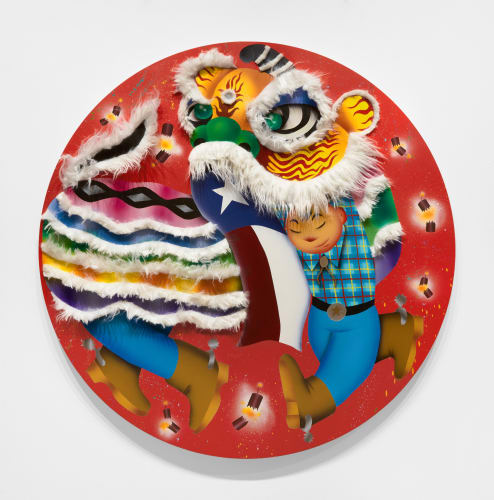Inman Gallery is pleased to present Western Bootleg, a solo exhibition of new work by Loc Huynh, on view May 5 - July 1, 2023. The show is concurrent with Jana Vander Lee: Still Time, presented in the south gallery. Please join us for an artists' reception on Friday, May 5, from 6-8pm. An artist talk between Loc Huynh and Jennifer Ling Datchuk will take place on Saturday, June 10 at 1pm. This is Huynh's first show with the gallery.
Drawing from the visual language of Pop and mass-market images, Loc Huynh paints figurative scenes that explore the hybridity of Vietnamese and Texan culture and diasporic Asian American identity. His technical practice blends airbrush techniques - a highly mechanical mark - with more painterly modes, taping off forms to create flat, crisp lines with smooth volumetric renderings. Introducing collage and other textured elements to the composition, Huynh creates dynamic, tactile surfaces that harmoniously balance the seemingly impersonal sprayed mark with warmth and humor. The resulting images are highly graphic and often biographical, with a nostalgic tone and playful tenor.
Western Bootleg presents three groupings of works, all playing with visual motifs sourced from recognizably Texan, Vietnamese, and Chinese cultural tropes. The images are derived from Vietnamese folk art in both Đông Hồ and Hàng Trống painting traditions, as well as lì xì, or lucky money, small red envelopes given to children to celebrate the first day of Tết Nguyên Đán (Lunar New Year). Huynh mixes these traditional and contemporary modes with Texan iconography to create a distinct and nuanced hybrid image, one that is emblematic of the artist's own identity. Referencing mass produced visuals from both Eastern and Western sources - from red envelopes to cowboy art, dragons to armadillos - the paintings embrace a "double kitsch," dissolving cultural hierarchies to present an immediate and democratized image.
The three groupings include first, the four women musicians from the Punk Rock Áo dài Cowgirl paintings. These works follow the tradition of Tứ bình, a line of Hàng Trống folk paintings dating back to the 16th century. Tứ bình works are characterized by a set of four, vertical panels in a thematic, serial format (e.g., the four seasons of the year or the four stages of life).[1] Here, Huynh riffs on the tố nữ imagery of four women playing different instruments,[2] with additional homages to four punk bands - Dead Kennedys, The Germs, Flipper, and Descendents - whose logos are on the accompanying vases, while Texan iconography adorns their dresses (áo dài). The black backgrounds and pearlescent halos mimic ebony lacquer paintings with mother of pearl inlay. Their staggered hanging mirrors the logo of the 1970s punk band, Black Flag.
The second grouping include the four Redneck Đông Hồ paintings featuring young children dressed in camo prints and denim cut-offs each cuddling a different animal native to the Texas gulf. These works combine animal motifs from Đông Hồ folk art with the aesthetics of lì xì envelopes, using red-gold coloring and cutesy imagery. The final three works each depict lion and dragon dances, which are performed at traditional and religious ceremonies, notably Tết or Lunar New Year. In the two Lion Dancers tondos the animated lions are adorned with collaged fur while the dancers are dressed in full Western wear with bolo ties and cowboy boot. The Great Rattle-Dragon Parade (2022) similarly draws from the Đông Hồ tradition, taking its composition from an anthropomorphic woodcut painting of rats performing a dragon parade. Here Huynh replaces the rats with regional armadillos and transforms the dragon into hybrid rattlesnake.
Imagining this exhibition like a game of visual telephone, Huynh takes a generative approach to act of reinterpretation and repurposing, celebrating what is created in these ongoing exchanges over what is lost in translation. "There is no such thing as a static painting," Huynh comments. In many ways these works are in motion. They are a testament to the evolving cultural fluidity they represent. They change and shimmer in the light with pearlescence and gold. Their soft furs and flowers flutter in the air. They are alive in their joy, and celebratory with a distinctly Texan - and particularly Houstonian - flair.
[1] Duong, Jenna. "The Spring portrays on "Tu Binh" folk paintings," Hanoi Times, January 30, 2022, https://m.hanoitimes.vn/the-spring-portrays-on-tu-binh-folk-paintings-319817.html
[2] Thương, Yến. "A Precious Piece of Hanoi Vietnam History Embodied in Hang Trong Paintings," Medium, October 1, 2018, https://medium.com/travel-is-to-think-in-terms-of-experiences-rather/a-precious-piece-of-hanoi-vietnam-history-embodied-in-hang-trong-paintings-f245b3381021

